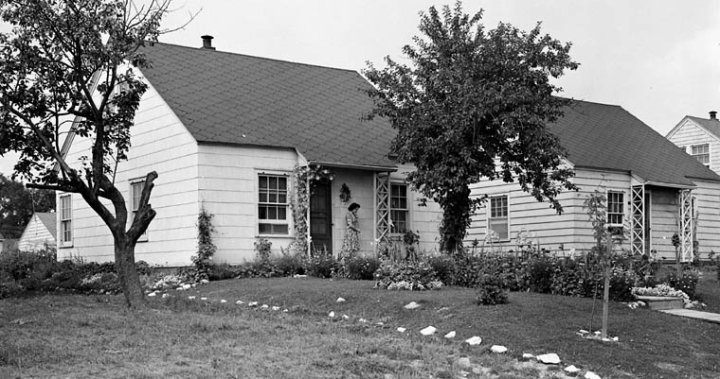The reveal of a new catalogue of pre-approved housing designs in British Columbia this week is raising questions about when a promised federal counterpart will be available.
And as the cost of living and unemployment rates continue to bite, advocates say the time is now to speed up the federal promise and do whatever can be done to build more homes, quickly — and try to make it easier to build pre-fabricated homes.
“In order to have a factory producing housing, you need a guarantee of a certain number of orders. And that’s very hard to do if you’re working with several different jurisdictions, all of whom have different rules as to what’s allowed and what isn’t,” said Carolyn Whitzman, senior housing researcher for University of Toronto’s School of Cities.
Pre-fabricated housing or prefab construction is a method of building where the bulk of the construction happens off-site, often in a facility like a factory.
Either a fully-constructed modular home or parts of a house are then shipped off to the location, where it is assembled and connected to utilities.
The potential has been a growing topic of conversation as provinces and the federal government eye ways to standardize and accelerate home building.
Having standardized designs means developers can cut through the red tape and start building quickly.
Whitzman said this is demonstrated by the city of Kelowna, B.C., which introduced standardized designs in 2022, well before the rest of the province.
“Kelowna can turn around approvals for these pre-approved designs in ten days. Whereas in, say, the GTA (Greater Toronto Area), approval for an infill design could easily take 18 months,” she said.
Whitzman said a federal catalogue is the need of the hour.
“Whichever level of government can do it should do it. It’s just a lot less efficient to have 750 municipalities, over 5,000 people making a whole bunch of changes than it is to have 10 provinces and three territories do it. And it’s most efficient to have national standards,” she said.
What is in the B.C. catalogue?
The B.C. government on Wednesday released a free catalogue of duplex, triplex, quadplex and townhouse designs that are compatible with the 2024 B.C. Building Code.

Get breaking National news
For news impacting Canada and around the world, sign up for breaking news alerts delivered directly to you when they happen.
These designs can be customized for different lot sizes and configurations for use throughout B.C.
A spokesperson for Housing, Infrastructure and Communities Canada told Global News that plan will support federal efforts, but did not answer when exactly the federal catalogue will be available beyond “late 2024.”
“British Columbia’s standardized design project is a great example of how provinces and territories can support our shared priorities on housing construction, and discussions with provinces and territories will continue as needed to ensure that different orders of government put appropriate mechanisms in place to support the adoption of catalogue designs,” the statement said.
Budget 2024 provided $11.6 million in 2024-25 to support the development of the Housing Design Catalogue for up to 50 designs.
The catalogue is currently in the Request for Proposals (RFP) phase, with the housing minister seeking design services “for the development of low-rise designs as part of the initiative.”
“Strawberry box” houses or “victory homes,” were built for returning Second World War veterans, and are still standing in many Canadian neighborhoods. On Tuesday, the federal government said it was reviving the policy.
Library and Archives Canada

Whitzman says Canada’s housing approach has been very “piecemeal” with every municipality having its own variation of the building code, design requirements and zoning bylaws.
“It’s impossible to build housing quickly and also to build infill housing in a standardized way,” she said.
“Kelowna was leading the way in designs. B.C. is now leading the way in terms of designs. And then hopefully the federal government will lead the way in terms of designs … the more that you can move up decision making to the higher level of government, the better it’s going to be.”

Singh said pre-approved designs will not only help speed up the construction process, but also lower construction costs and avoid delays.
While Singh called for action at the federal level, she said more provinces also have to pull their weight as Canadians continue to face housing and financial challenges.
Singh said some provinces, like her home province of Ontario, do not see eye to eye with Ottawa.
“Given the often politicized nature of the relationship between the Ford government and the Trudeau government, I worry that this could end up in the good-ideas-never-done pile,” she said of implementing the housing catalogue.
She noted that Mississauga, Ont., also now has two pre-approved designs that can be downloaded off of the city website.
“What this shows us is that there is an appetite from municipalities for pre-approved designs, and would benefit from the province adopting a national catalogue,” said Singh.
According to the Canada Mortgage and Housing Corporation, Canada will need nearly 3.5 million additional new homes by 2030.
A federal catalogue of designs would not be new for Canada.
When thousands of veterans returned to Canada after the Second World War, Canada was facing a housing crisis. To cut through the red tape and accelerate the building and approval process, Ottawa released a catalogue of pre-approved home designs that builders could start constructing straight away. Hundreds of thousands of new homes were built in Canada over a short period of time.
In December, Housing Minister Sean Fraser announced that the Liberals were taking the nearly 80-year-old program off the shelf and revamping it.
© 2024 Global News, a division of Corus Entertainment Inc.










